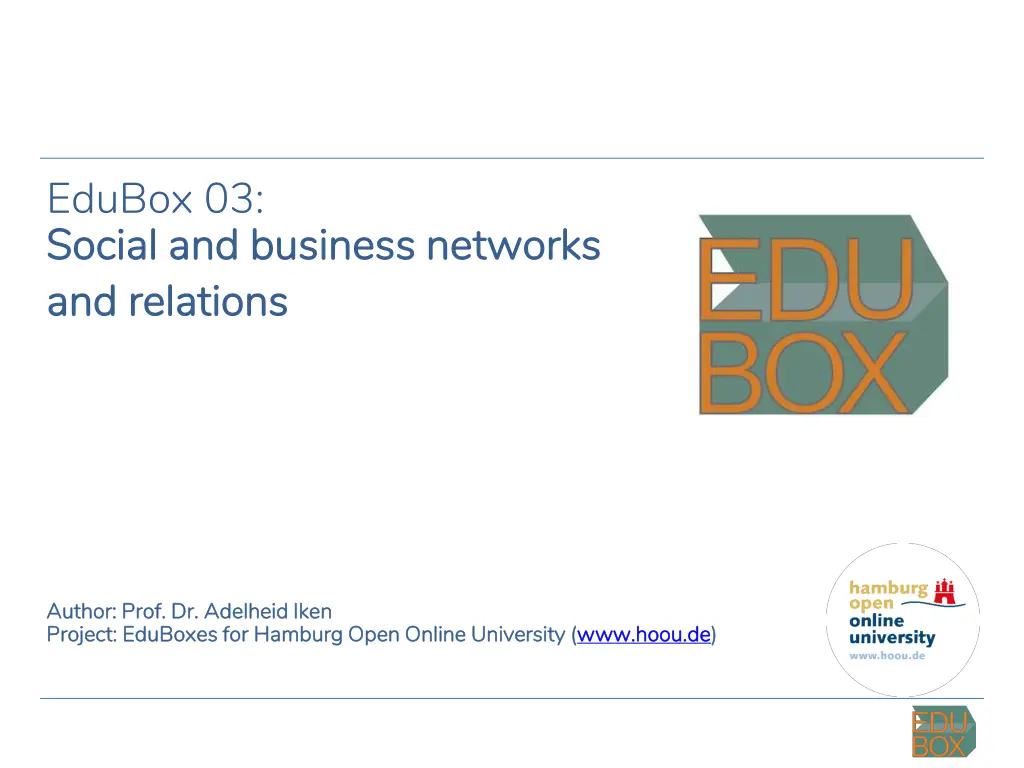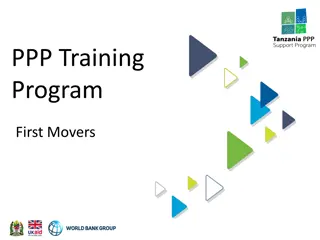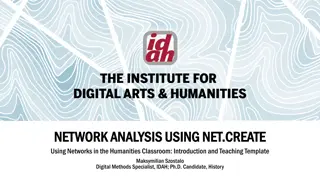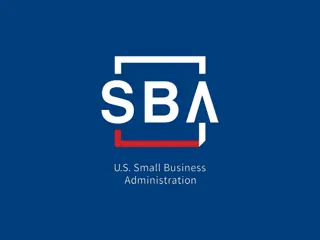
Understanding Social Networks: An Introductory Analysis
Explore the complexities of social networks within global relations through the lens of network analysis, equipping students with tools to enhance meaningful relationships and make informed interventions. Dive into the basics of social network analysis to unravel the ties and dynamics shaping our interconnected world.
Download Presentation

Please find below an Image/Link to download the presentation.
The content on the website is provided AS IS for your information and personal use only. It may not be sold, licensed, or shared on other websites without obtaining consent from the author. If you encounter any issues during the download, it is possible that the publisher has removed the file from their server.
You are allowed to download the files provided on this website for personal or commercial use, subject to the condition that they are used lawfully. All files are the property of their respective owners.
The content on the website is provided AS IS for your information and personal use only. It may not be sold, licensed, or shared on other websites without obtaining consent from the author.
E N D
Presentation Transcript
EduBox 03: Social and business networks Social and business networks and relations and relations Author Author: Prof. Dr. Adelheid Iken : Prof. Dr. Adelheid Iken Project: Project: EduBoxes EduBoxes for for Hamburg Open Online University ( Hamburg Open Online University (www.hoou.de www.hoou.de) )
INTRODUCTION TO EDUBOX 03 One of the features of the socio-cultural and economic changes linked to globalisation and the digitalisation of communication is that we are increasingly entangled in a web of local and global relations. We not only need to understand these webs as networks and the impact these changes have on building and maintaining personal and business relations, but also have tools at hand for analysing these relationships and enhance our ability to develop and maintain meaningful relationships, which cut across local as well as global fields. Against this background, this EduBox introduces a network approach to social relations and provides students with the basic principles of network analysis and net mapping. This unit thus enables students to make well-founded suggestions for interventions and decisions within networks based on an appraisal of their complex structures and the relations between the various actors within these networks.
EduBox 03: Social and business networks Social and business networks and relations and relations Session 03: A A social social network network analysis analysis, , the the basics basics Author: Prof. Dr. Adelheid Iken Author: Prof. Dr. Adelheid Iken Project: EduBoxes for Hamburg Open Online University ( Project: EduBoxes for Hamburg Open Online University (www.hoou.de www.hoou.de) )
STUDYING SOCIAL RELATIONS Introduction to Session 3 Social networks are becoming more complex and are increasingly cutting across different fields of life. By using a social network analysis to study these relations, the various links between actors become visible, as well as the densities, strengths and weaknesses of the ties. Thus, a social network analysis is not only able to help us to understand complex social relations but can also provide us with a basis to manage them and consider interventions carefully. The purpose of this session is therefore to introduce students to the basic tools of social network analysis.
ICONS Discussion / Reflection Tasks / Home Assignment Learning Outcomes / Objectives Summary License Video
LEARNING OUTCOME Students analyse social networks by applying the basic tools of a social network analysis
OBJECTIVES By the end of these sessions, students will be able to explain the basic features of a social network analysis, analyse a network and use the results of the analysis to make suggestions for interventions
STUDYING SOCIAL RELATIONS Topics Learning outcome Objectives Lead-in Social network analysis (SNA) A definition Basic features Analysing networks Pros and cons of a network analysis Summary and reflection Home assignment Sources
LEAD-IN Who has a Facebook account? Who is a member of XING or LinkedIn? Please raise your hands Why are they networks? What characterises them? Does anyone believe that you can create value using these networks? Has anyone conducted a Network Analysis? Any ideas what this could involve? CC0 Source: pixabay
LEAD-IN There is a saying that the effectiveness and power of an individual in an organization depends not just on his or her position in the formal hierarchy, but on the person s place in a variety of networks. Is there truth in this and if so, why? CC0 Source: pixabay
LEAD-IN It is hard to accept the fact that there are people who play critical roles who don t show up in the organisation chart. I ve never heard anyone say: This person is a hard networker and deserves a raise. But network analysis gives us a tool to measure the contribution of these social types. (Malcolm Gladwell) What could be positive about being a hard networker and what could be negative about it?
SOCIAL NETWORK ANALYSIS (SNA) A definition A social network can be understood as a specific set of linkages among a defined set of persons, with the additional property that the characteristics of these linkages as a whole may be used to interpret the social behaviour of the persons involved (Mitchell 1969: 2)
SOCIAL NETWORK ANALYSIS (SNA) A definition Social network analysis [SNA] is the mapping and measuring of relationships and flows between people, groups, organizations, computers, URLs, and other connected information/knowledge entities. The nodes in the network are the people and groups while the links show relationships or flows between the nodes. (Krebs 2013)
SOCIAL NETWORK ANALYSIS (SNA) Basic features An ego- and a group- network Ego Network Group Network
SOCIAL NETWORK ANALYSIS (SNA) Basic features An undirected graph A directed graph
SOCIAL NETWORK ANALYSIS (SNA) Basic features In-degree Out-degree Reciprocal
SOCIAL NETWORK ANALYSIS (SNA) Basic features Betweenness Closeness
SOCIAL NETWORK ANALYSIS (SNA) Basic features The strengths of ties Another aspect to consider is the strength of ties, which is indicated by the thickness of the link between actors.
SOCIAL NETWORK ANALYSIS (SNA) Basic features Granovetter (1983) argues that weak ties could actually be more advantageous than strong ties because weak ties allow an individual to reach a higher number of other individuals and it makes it easier to reach individuals outside of one s densely tied social group. Think about this statement for example in the case of seeking information. Do you think he is right and if so, why?
SOCIAL NETWORK ANALYSIS (SNA) Basic features Weak ties low low low extensive short-term party memberships, colleagues low costs, flexible fluctuation innovation (brokerage) lack of solidarity getting a new job Strong ties high high high limited long-term Source:BBased on Stark 2014 Investment Frequency Intensity Sphere Duration Examples friends, family Advantages Disadvantages Possibilities Risks Examples insider information high costs trust, influence, solidarity restraints getting help
SOCIAL NETWORK ANALYSIS (SNA) Basic features A kite network https://www.destatis.de/DE/Publikationen/Datenreport/Downloads/Datenreport2016Kap2.pdf?__blob=publicationFile Source: own figure, based on Statistisches Bundesamt 2016: 44 Maria Hassan Toby Thorben Mohammad Heather Vivien Central player/hub Boundary spanner Peripheral player Fernanda Edward Lyudmila Source: own figure, based on Krebs 2013 & Statistisches Bundesamt 2016: 44
SOCIAL NETWORK ANALYSIS (SNA) Basic features There are a huge variety of issues that can be dealt with applying a network analyses such as Collaboration graphs are linked to the question of who works with whom. Who-talks-to whom graphs show people sharing information, communicating via email, making telephone calls, whereby the nodes can represent customers, employees, co-workers etc., and Formal and informal lines of decision making
SOCIAL NETWORK ANALYSIS (SNA) Basic features Activity 1: From text to network Use the text and visualise the information as a network. Interview Company A: In my company, I'm the only one who knows what to do when our production machinery is broken. I know three companies specialized in maintaining and repairing such machinery. Mr. Mayer is a colleague of mine and he is the only sales representative. He travels around the world all year and he knows so many people. Our boss is so busy, she doesn't have time for that. The company employs 5 people. A friendly atmosphere exists between my colleagues and myself, but our boss is awful. I think if my colleagues weren t so nice I would have quit my job. (Source: Stark 2014)
SOCIAL NETWORK ANALYSIS (SNA) Basic features Interview Company B: In the morning our boss is the first in the company and in the evening he leaves the company last. If someone has a problem, then all employees go straight to the boss. In a four-on-one meeting you can talk to him about anything. The working atmosphere is good, but I would not meet my colleagues after work. Our boss likes that. He doesn t like it when colleagues are friends with each other. For him, only one thing counts: work. He works even at the weekend and acquires new orders. That's why he joined the golf club. (Source: Stark 2014)
SOCIAL NETWORK ANALYSIS (SNA) Analysing networks Activity 2: Analyse the formal structure and compare it with the informal structure as shown on the following slide. Where do you see communication problems? Which role do the different key players have? Based on your analysis what should the head of the division do and why?
SOCIAL NETWORK ANALYSIS (SNA) Analysing networks Source: Based on Cross 2004
SOCIAL NETWORK ANALYSIS (SNA) Analysing networks (see notes) Activity 3: The following three slides show a work, a social and a career advice network. Sit with your neighbour and analyse the role and situation of Martin and Bianca. Considering that the CEO is about to retire, whom do you think he will promote as his predecessor and why? Considering your analysis, what implications could this have for the successful functioning of the company? What would be your advice?
SOCIAL NETWORK ANALYSIS (SNA) Analysing networks Work network CC BY-SA 4.0 Source: Julia Flitta (2018), based on Kleiner 2002
SOCIAL NETWORK ANALYSIS (SNA) Analysing networks Career advice network CC BY-SA 4.0 Source: Julia Flitta (2018), based on Kleiner 2002
SOCIAL NETWORK ANALYSIS (SNA) Analysing networks Social network CC BY-SA 4.0 Source: Julia Flitta (2018), based on Kleiner 2002
SOCIAL NETWORK ANALYSIS (SNA) Analysing networks Six varieties of networks The work network (with whom do you exchange information on a day-to-day basis?) The social network (with whom do you correspond to find out what is going on in the office?) The Innovation network (with whom do you exchange ideas?) The Career Guidance or Strategic Network (whom do you approach for advice linked to your future?) The Learning network (with whom do you relate in order to improve approaches and methods?) (cf. Kleiner 2002)
SOCIAL NETWORK ANALYSIS (SNA) Analysing networks Activity 4: On the following chart you can see the results of a network that answers the question with whom in this class did you socialise (i.e. did something together outside of the university during the past six months)? . Analyse the network considering betweenness and closeness, type of link (out-degree; in-degree or reciprocal) and the roles people have in the network (central player/hub, boundary spanner or peripheral player) What are the advantages and the disadvantages of having these roles?
SOCIAL NETWORK ANALYSIS (SNA) Analysing networks Ntor Bel Ha Pav Bou Kre Dim Lo Li Plie Gro Elit Bud So Th Ni Fis Els Is To Kha Bra
SOCIAL NETWORK ANALYSIS (SNA) Analysing networks Activity 5: On the following chart you can see the results of a network that answers the question who in this class can you approach if you have problems linked to assignments? . Analyse the network considering betweenness and closeness, type of link (out-degree; in-degree or reciprocal) and the roles people are having in the network (central player/hub, boundary spanner or peripheral player) What are the advantages and the disadvantages of having these roles?
SOCIAL NETWORK ANALYSIS (SNA) Analysing networks Plie Kha So Bell Dim Th To El Gro Elit Kre Bra Is Bu Fisc Ni Ha Li Ntc Bo Pav
SOCIAL NETWORK ANALYSIS (SNA) Analysing networks Discuss with your neighbour Imagine you needed some information to reach as many people as possible, who would you approach to pass on this message? If you wanted students in class to become more socially connected, what would you do and how would you do this? Imagine the networks depicted a department, what would be reasons to develop the social as well as the support network? What would be some ways of doing so?
SOCIAL NETWORK ANALYSIS (SNA) Analysing networks Marketing Finance Manufacturing Kevin Sal Sonya Lisa Julia Lee John Paul Halen David Carl Sue Alex Ali Bill Hub / network centralisation Boundary spanner Peripheral players
SOCIAL NETWORK ANALYSIS (SNA) Analysing networks As a result of a major restructuring process and the employment of new people, communication does not seem to flow as well as it might. This is why two departments have been chosen for a SNA analysis. You are now asked to discuss the results with the people in the department. Sit with your neighbour and think about questions you would like to ask and why?
SOCIAL NETWORK ANALYSIS (SNA) Analysing networks
SOCIAL NETWORK ANALYSIS (SNA) Analysing networks
SOCIAL NETWORK ANALYSIS (SNA) Pros and cons of a network analysis The SNA helps to visualise structures based on the information available at the time of the data collection. This means they are not able to indicate changes (e.g. after a get-together or workshop) The result of a SNA is thus a static image and the information can therefore be deceptive and needs to be interpreted with caution. Structures can show you e.g. that information travels from A to B and B to C, but does not show whether the information from A reaches C via B, so it does not indicate the quality of the route. But these structural maps can show the complexity of interrelations, evaluate the location of actors in the network and thus move beyond initial perception, putting the focus on interaction rather than individual behaviour, helping us to understand roles people in the network have Generally speaking the results of a SNA should be used as a basis for discussion and to analyse processes and understand how communication works with the people involved.
SOCIAL NETWORK ANALYSIS (SNA) Pros and cons of a network analysis Watch the following Ted lecture of 16 minutes by Vladis Krebs on social networks: http://www.youtube.com/watch?v=R-y71DEMZHc Note down the dangers he envisages of making networks visible. Can you relate to these dangers in connection with your social and work related networks? Think about facebook and other social media.
SOCIAL NETWORK ANALYSIS (SNA) Pros and cons of a network analysis Watch the YouTube video Social Networking in Plain English : https://www.youtube.com/watch?v=6a_KF7TYKVc Note down the negative aspects of being a member of such social networks.
SUMMARY AND REFLECTION Reflection Is it important to see the structure and the process if we really want to understand who interacts with whom, for what reason, and what the bottlenecks may be? Take a position and argue your point. CC0 Source: pixabay
SUMMARY AND REFLECTION Summary Social network analysis is a tool to analyse for example existing structures, workforce composition, information channels and links of trust and support It can serve as a tool and basis to improve organizational effectives (e.g. knowledge exchange, post-merger integration, process improvement, organizational reorganization) However, the results should be used with caution because they show a structure captured at a certain point in time. In order to benefit from a SNA analysis it is thus important to also include information showing processes.
HOME ASSIGNMENT Home assignment 1: Read the case study by Pirani 2017 https://www.dgroups.info/2017/09/case-study- dgroups-rwsn/ and summarise what they were able to achieve due to networking including the main lessons learned in order to make them into an active group.
SOURCES Chua, Vincent, Julia Madej & Barry Wellman 2011. Personal Communities: The World According to Me. In: John Scott and Peter J. Carrington (eds.). The Sage Handbook of Social Network Analysis. London : Sage Publications, 2011, pp. 101-115 Cross, Rob. 2004. Introduction to Organizational Network Analysis. https://gates.comm.virginia.edu/rlc3w/sna.htm 8.9.2018 Cross, Rob; Andrea Parker and Steve Borgatti. 2002. IBM A bird s-eye view: Using social network analysis to improve knowledge creation and sharing. IBM Corporation http://www.analytictech.com/borgatti/papers/cross,%20parker%20and%20borgatti% %20A_birds_eye_view.pdf 9.9.2018 Dekker, Rianne & Godfried Engbersen. 2012. How social media transforms migrant networks and facilitate migration. IMI Working Paper 64, University of Oxford; November 2012 Easley, David & Jon Kleinberg 2010. Networks, Crowds, and Markets: Reasoning about a Highly Connected World. Cambridge: Cambridge University Press Granovetter, Mark 1983. The Strength of Weak Ties: A Network Theory Revisited. In: Sociological Theory, Vol. 1; pp.201-233 Kleiner, Art. 2002. Karen Stephenson s Quantum Theory of Trust. In: Strategy+business, Vol 29 https://www.strategy- business.com/article/20964?_ref=http://www.managementplace.com/fr/mng/synthese_139a/index.php3&pg=0 7.9.2018 Knox, Hannah; Mike Savage and Penny Harvey. 2006. Social networks and the study of relations: networks as method, metaphor and form. In: Economy & Society. Vol 35, No1; pp.113-140. Krebs, Valdis. 2013. Social Network Analysis: An Introduction. http://www.orgnet.com/sna.html 7.9.2018 20-
SOURCES Mitchell, Clyde 1969. The Concept and Use of Social Networks. In: Mitchell, Clyde (ed.) Social networks in Urban Situations: Analyses of Personal Relationships in Central African Towns. Manchester: The University Press. pp. 1-50. Martin, Alexandra & Barry Wellman 2011. Social Network Analysis: An Introduction. [ed.] John Scott and Peter J. Carrington. The Sage Handbook of Social Network Analysis. London: Sage Publications, 2011, pp.11-25 Scott, John 2009. Social network analysis: A Handbook. London: Sage Schnegg, Michael & Hartmut Lang 2002. Netzwerkanalyse, eine praxisorientierte Einf hrung http://ethnographic-methods.org/wp-content/uploads/2018/08/Netzwerkanalyse.pdf 12.9.2018 Schweizer, Thomas (Ed.) 1989. Netzwerkanalyse: Ethnologische Perspektiven. Berlin: Reimer-Verlag Statistisches Bundesamt (Ed.) 2016. Datenreport 2016. Ein Sozialbericht f r die Bundesrepublik Deutschland. Bonn: Bundeszentrale f r politische Bildung/bpb https://www.destatis.de/DE/Publikationen/Datenreport/Downloads/Datenreport2016.pdf?__blob=publicationFile 14.9.2018 Except where otherwise noted, content in this presentation / on this site is licensed under a Creative Commons Attribution Share Alike 4.0 International license.





















